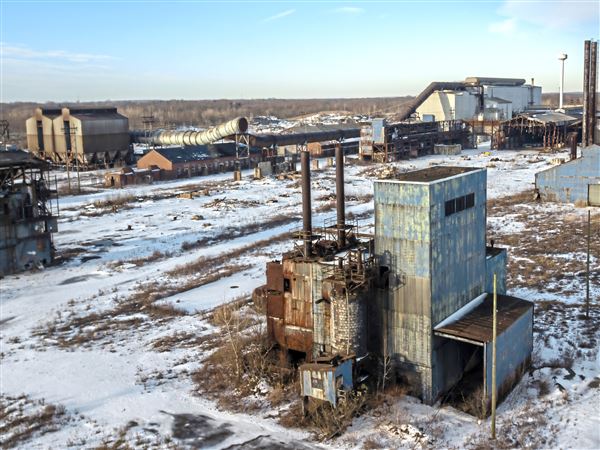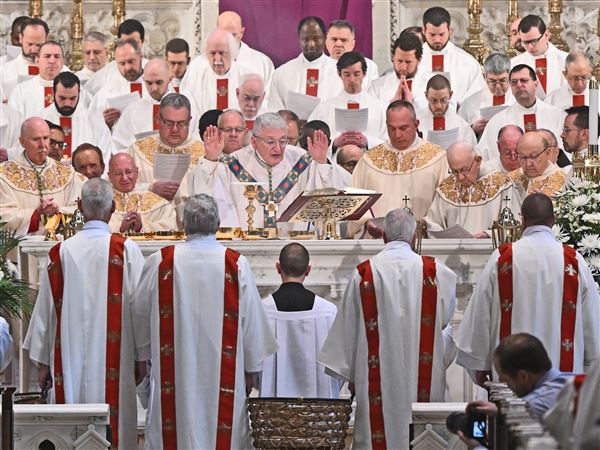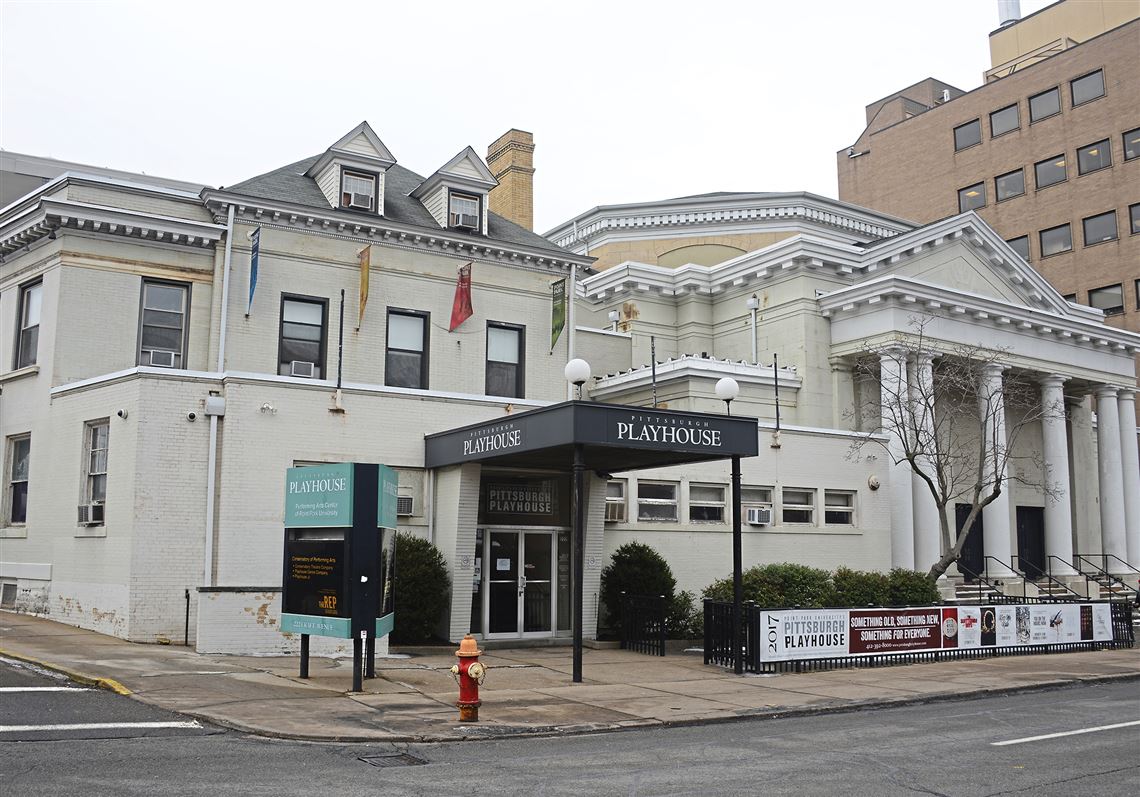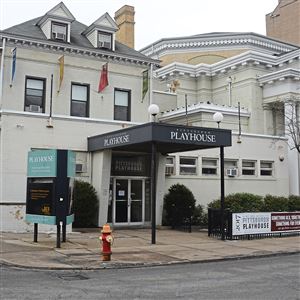The past is present in every nook and cranny of the Pittsburgh Playhouse, and there are about a million nooks and countless crannies.
You could easily get lost amid hallways and steps as haphazardly placed as Harry Potter’s Hogwarts School of interchangeable stairways. Then Kim Martin points out peeling, crusty signs that you are standing in the remains of a swanky, spacious restaurant, where 45 years ago you could enjoy a veal parm for $3.50 and head upstairs to catch the latest Playhouse production.
As you pick your way carefully through the props and scenery, it’s easy to imagine you are in a time warp, where theatrical murals, water features and leather-padded doors once greeted up to 250 diners on any given night.
Today, the red carpet is faded, the wall coverings and doors are peeling, the kitchen meat locker is now used to hold rows of costume suits, and the Playhouse is about breathe its last.
When: Friday (preview Thursday) through Feb. 18. 8 p.m. Thursday-Friday, 2 and 8 p.m.. Saturday and 2 p.m. Sunday.
Tickets: $24-$29 ($15 seniors, $10 students); 412-392-8000 or www.pittsburghplayhouse.com.
Lights Out! farewell celebration: 7-10 p.m. June 18 at the Pittsburgh Playhouse, 222 Craft Ave., Oakland. Tickets go on sale on March 15 at 412-392-8000 or www.pittsburghplayhouse.com.
On June 18, the Playhouse will hold a “Lights Out!” as a final public celebration of 85 years of memories and the building’s place in Pittsburgh theater history.
The next production, David Lindsay-Abaire’s “A Devil Inside,” opens Friday and will be the last performed in Oakland by the Playhouse Rep, the professional company of Point Park University.
The school’s conservatory companies will continue there into the spring, before the Playhouse at 222 Craft Ave. closes its doors for good and a multimillion-dollar three-theater facility with the same name emerges Downtown, within a stone’s throw of the university.
Directing the final play will be the Playhouse’s producing director, Ms. Martin, who was a Point Park student from 1983-87 and worked for the dance department Downtown for a short stint before “I finally settled back in for good in 1999.”
She led a tour of what appeared to be every inch of the Playhouse, but not quite. “I still find places I’ve never been in,” she said.
Ms. Martin recalls a time in the 1990s when she had to be in the building on a Saturday and accidentally tripped an alarm. The police came rushing through a doorway that she didn’t know existed.
The Playhouse, a mash-up of three buildings, came into being courtesy of the Rauh family. Local advertising magnate Richard S. Rauh married noted Pittsburgh actress Helen Wayne, and for her, he organized the Pittsburgh Civic Playhouse. The oldest part of the theater is a former German social club, hard by Hamlet Street, that became the Rauh Theatre, which held its first production in 1934.
The current lobby was an adjacent house, “the second thing to be bought by the Rauhs,” Ms. Martin explains. “The house became its offices. Then, when the Tree of Life synagogue moved to Squirrel Hill, it was added and became the largest of the three theaters, the Rockwell Theatre.”
The third theater is the black box Studio Theatre, entered via an alleyway on Craft Avenue and where “A Devil Inside” will open on Friday.
“From across the street, you can still see a menorah atop the building, and there is a cornerstone that says ‘Erected 5666’ — that’s the Jewish calendar year 1906, when the synagogue was dedicated,” Ms. Martin points out. “The stained-glass windows and dome were removed or covered, light being the enemy of theater.”
Inside, she points out the domed ceiling that has been the bane of sound designers and among the many reasons her nostalgia has been tempered by the excitement of moving into “a new space that is built to be a theater instead of converted,” she says.
Backstage left is a feature of the Playhouse that is rare and huge and hiding in plain sight to the untrained eye.
“This is one of two surviving paint frames in the nation,” Ms. Martin explains. “Our scenic artists can paint, stretch drops, scrims, whatever they need and paint. It’s two stories high, which is probably why they are not too popular, but they can raise it and lower it and goes up and down. Most people are trained now to paint on the floor, so when we move to the new Playhouse, we will be painting on the floor.”
As you make your way through the larger scenic elements, a seemingly unexceptionable claw-foot bathtub catches Ms. Martin’s eye. “I love that tub,” she says. “It’s a workhorse.”
Not far from the crowded space of timeless light fixtures, chairs and couches are rooms filled with old communications devices, from typewriters to early computer screens, and against a wall, a lineup of upright vacuum cleaners represents decades of cleaning for real and onstage.
In the Lillian Russell Room, a former ballroom beneath the Rockwell Theatre, there was what was to be a mural by The Line King, New York Times illustrator Al Hirschfeld.
“When we were getting ready to make the move, they wanted to authenticate it. They found pictures of Al Hirschfeld in his apartment, and it was the same mural, but it was wallpaper he had designed,” Ms. Martin says.
Consultants also inspected what was thought to be wallpaper on a corner wall of the former restaurant and discovered it was painting on muslin. Barbara Villanova tracked down the technical director of the Playhouse from the 1970s, now in his 90s and living in Ohio, who explained that when they renovated the restaurant and wanted to match the Hirschfeld mural, he painted the wallcovering of twisted columns and steps that remains today.
The massive boiler that heats the Playhouse complex reminds Ms. Martin of a Stephen King novel. “In ‘The Shining,’ he has to keep stoking and stoking the boiler, and that’s what I’d liken this thing to. We keep coming down and going, ‘Three more months.’ If this goes ...” she trails off, her hands in prayer position.
There have been moments in recent years when Ms. Martin thinks she may not miss the building where Shirley Jones got her start and Jane Alexander debuted Thom Thomas’ drama “A Moon to Dance By” in 2009, and where several of Pittsburgh playwright Tammy Ryan’s plays have had their world premieres.
It’s also a place where performers have reported hearing footsteps near the men’s dressing room and believe they belong to the actor John Johns, who died of a heart attack at the Playhouse in 1963.
The final Rep production is a twisted revenge thriller that the Los Angeles Times described as “indescribably wacky,” and The New York Times recommended as, “Murder, gore and psychosis, all purposeful and funny.”
“Someone recently asked me why I picked this show, and I told them, ‘Because it entertained me,’” says Ms. Martin. “It’s funny, it’s violent, it’s bloody and hilarious — it’s all the things I love and hope others will, too.”
As she prepared the production, she bounced back and forth between being wistful for the past and wishful about the future in the new venue.
“It is a crazy building,” she says. “I used to be so nostalgic about it. Then working here year after year and seeing it fall apart all around us, I can’t wait until it just doesn’t rain through a lighting fixture anymore.”
Sharon Eberson: seberson@post-gazette.com or 412-263-1960. Twitter: @SEberson_pg.
First Published: January 31, 2018, 4:44 p.m.


















